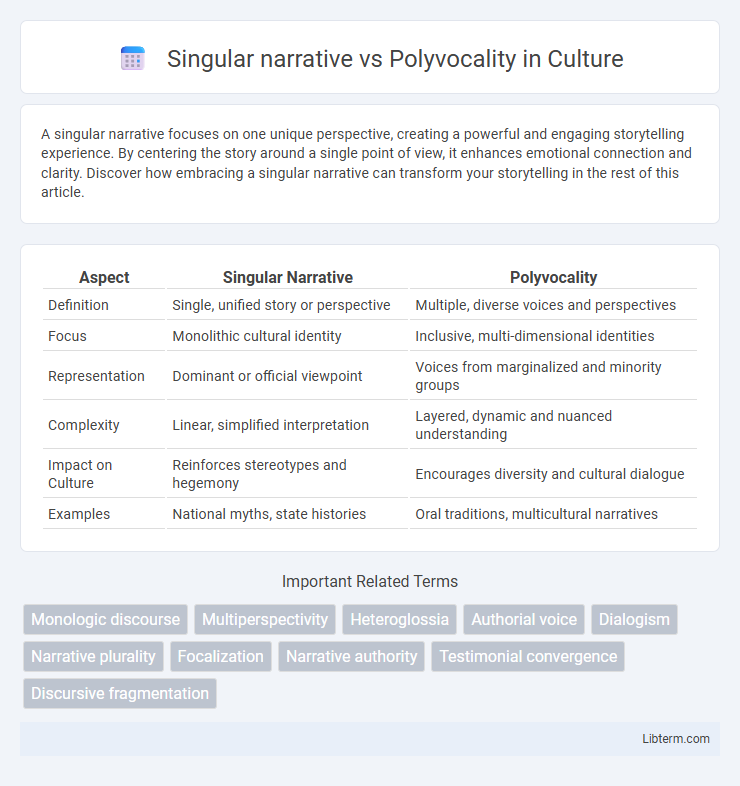A singular narrative focuses on one unique perspective, creating a powerful and engaging storytelling experience. By centering the story around a single point of view, it enhances emotional connection and clarity. Discover how embracing a singular narrative can transform your storytelling in the rest of this article.
Table of Comparison
| Aspect | Singular Narrative | Polyvocality |
|---|---|---|
| Definition | Single, unified story or perspective | Multiple, diverse voices and perspectives |
| Focus | Monolithic cultural identity | Inclusive, multi-dimensional identities |
| Representation | Dominant or official viewpoint | Voices from marginalized and minority groups |
| Complexity | Linear, simplified interpretation | Layered, dynamic and nuanced understanding |
| Impact on Culture | Reinforces stereotypes and hegemony | Encourages diversity and cultural dialogue |
| Examples | National myths, state histories | Oral traditions, multicultural narratives |
Defining Singular Narrative and Polyvocality
Singular narrative refers to a coherent, unified story that presents a single perspective or interpretation, often simplifying complex events into one dominant viewpoint. Polyvocality embraces multiple voices and perspectives coexisting within a narrative, highlighting diversity and contesting a single, authoritative account. This approach enriches understanding by incorporating varied experiences, cultural contexts, and interpretations.
Historical Contexts of Narrative Forms
Singular narratives often dominate historical accounts by presenting a single, authoritative perspective, typically reflecting the views of those in power. Polyvocality in historical narratives incorporates multiple voices and perspectives, including marginalized or suppressed groups, offering a more complex and inclusive understanding of past events. This shift challenges traditional historiography by emphasizing the diversity of experiences and the contested nature of historical memory.
Power Dynamics in Storytelling
Singular narratives often reinforce dominant power structures by presenting a single, authoritative perspective that marginalizes alternative voices and experiences. Polyvocality challenges this by incorporating diverse viewpoints, disrupting hierarchical storytelling and enabling more equitable representation of varied identities and truths. This multiplicity in narratives exposes power imbalances and promotes critical engagement with authority in cultural and historical discourse.
The Impact on Audience Perception
Singular narratives present a unified perspective, often simplifying complex issues but limiting audience interpretation and critical thinking. Polyvocality incorporates multiple voices and viewpoints, enriching the audience's understanding by presenting diverse experiences and challenging dominant assumptions. This multiplicity in storytelling fosters empathy and encourages audiences to engage more deeply with the subject matter, enhancing cognitive and emotional impact.
Polyvocality in Contemporary Media
Polyvocality in contemporary media emphasizes the inclusion of multiple perspectives and voices, challenging the dominance of singular narratives that often marginalize minority experiences. This approach enhances the richness of storytelling, allowing diverse cultural, social, and political viewpoints to coexist and interact within digital platforms, social media, and transmedia projects. By fostering dialogue among varied narratives, polyvocality promotes democratic engagement and reflects the complexity of modern societies more accurately than single-threaded storytelling.
Challenges of Embracing Multiple Voices
Embracing multiple voices in polyvocal narratives challenges the coherence and clarity often found in singular narrative structures, requiring complex strategies to balance diverse perspectives without diluting the core message. The integration of varied viewpoints risks creating fragmentation, making it difficult for audiences to discern a unified theme or truth. Managing conflicting interpretations demands careful editorial decisions to ensure inclusivity while maintaining narrative engagement and impact.
Case Studies: Literature and Film
Singular narratives assert a unified, authoritative perspective often exemplified in classic literature like Harper Lee's "To Kill a Mockingbird," which centers on Scout Finch's singular viewpoint to shape the reader's moral understanding. Polyvocality in film and literature, as seen in Akira Kurosawa's "Rashomon," employs multiple conflicting perspectives to challenge the notion of objective truth and emphasize subjective experience. These case studies demonstrate how singular narratives streamline interpretation, while polyvocality multiplies layers of meaning, enriching audience engagement through diverse voices.
Cultural Representation and Identity
Singular narratives often present a monolithic perspective that can marginalize diverse cultural identities and limit authentic representation. Polyvocality embraces multiple voices, capturing the complexity and plurality of cultural experiences that shape identity formation. This approach fosters richer cultural understanding and resists homogenizing tendencies in storytelling.
Ethical Considerations in Narrative Choices
Ethical considerations in narrative choices demand acknowledgment of diverse voices to avoid marginalization inherent in a singular narrative. Polyvocality promotes inclusivity by representing multiple perspectives, ensuring narratives reflect complex social realities authentically. Prioritizing ethical storytelling requires balancing dominant narratives with marginalized voices to foster empathy and social justice.
The Future of Narrative Diversity
The future of narrative diversity hinges on embracing polyvocality, showcasing multiple perspectives that reflect global cultural complexities beyond singular narratives. Emerging storytelling platforms and technologies amplify diverse voices, fostering inclusive literary ecosystems that challenge traditional monolithic viewpoints. This shift enriches societal understanding by prioritizing marginalized experiences, driving innovation in media, literature, and education.
Singular narrative Infographic

 libterm.com
libterm.com